The
|
The
|
| Back in the 60's the good people at the Leslie headquarters in Pasadena, California, found yet another way to expand the market for the Leslie speaker: They developed a chrome wedge-shaped gizmo that would allow any audio signal to be connected to the Leslie speaker. Now, one *could* assume that the need for a 1/4" jack input came from guitar players of the flower-power-acid-progressive rock scene, and true - many of the really big names experimented with the Leslie guitar sound - Jefferson Airplane and Quicksilver Messenger Service are two West Coast names that spring to mind. (British bands of the more experimental scene with Pink Floyd as perhaps the greatest contributor, and of course The Beatles, used the Leslie for almost anything imaginable - drums, vocals, piano - you name it.) I don't really buy that ;-) - the Leslie
guitar sound while now famous for its connection with the 60s was not the main factor
here. I believe that the market for owners of so-called combo organs (Farfisa, VOX, Gibson
etc.), accordions and other types of reed-style instruments was a much more
interesting potential buyers of Leslie speakers. The new invention was a neatly designed stomp-box with two 1/4" jack inputs, separate volume control knobs, a foot controlled fast/slow button, a yellow light for tremolo indication, a red light for power and of course the 6 pin amphenol socket where the Leslie cable was plugged into. Also mounted on the box was a line cord both for supplying the Combo Preamp's internal circuitry with power and passing power on to the Leslie cabinet through the 6-pin connector. The first model, simply called Leslie Combo Preamp, was made to interface with the type 147 power amplifier. When the solid state ProLine Leslie models came along, a matching combo preamp was issued. Yet another three models were developed during the 70's to mate with new types of Leslie speakers. They differ in the way they interface with the cabinets, the number of control buttons, the way they are powered but they all provide the same basic element of signal matching and motor/rotor control. The Leslie 147 is now in production again, as are other models with different specs, but the Combo Preamps have all been discontinued. One could with good reason claim that while the old tube Leslie designs are very versatile, and therefore still on the market, the early solid state design of the Combo Preamps would not be satisfactory by today's standards. Aftermarket Combo Preamps, on the other hand, can be bought at reasonable prices, offering a far better sound than the noisy, buzzy sounding transistor designs of the 60s and 70s. The Trek II model UC-1A is very well built and also good value for money. Other models from other companies are more expensive but may offer a wider range of tonal control and a tube-based design. The intention with this web-page is to allow the reader, together with Uncle Harvey's Guide to Leslie Pin-outs, to determine which combo preamp that can be used with a given Leslie or the other way around - given a preamp, what cabinet model it will work with. The different models are listed below: |
| Combo Preamp Model | Type # | Use with Leslie speaker model | Pin-out |
|---|---|---|---|
| Leslie Combo Preamp | 7875 | 47/45, 147/145/247/245, 125/225 etc. | 6W |
| Leslie Combo Preamp II | 7370 | 760, 770, 825 ( and 700, 710)* | 9 |
| Leslie Combo Preamp De Luxe | 7420 | 900, 910, 925, 950 | 9 |
| Leslie Combo Preamp III | 7880 | 330, 860, 820, 771, 815, 722HL, etc. | 11 |
| Leslie Combo Preamp IV | 7884 | 330, 860, 820, 771, 815, 722HL, etc. | 11 |
Type #'s refer to the 117V/60Hz standard US issues. The 240V/50Hz version of the original Combo Preamp has # 9875.
*Leslie 700, 710 need to be converted to
single channel input with a
TrekII
crossover network in order to work with a combo preamp.
| Leslie Combo Preamp FAQ Q: Is there a Combo Preamp that will work with a Leslie 122? A: No and yes. Since a Leslie 122 (and other Hammond-type models) were designed and sold to be used with console Hammond organs, where a combo preamp would never be needed anyway, such a model was never made. The Trek II model of today, however, can be used with any single channel Leslie including model 122/22H/31H etc.
A: Yes, in most cases. The first Leslie Combo Preamp can be made to work with 9-pin Leslies but you won't have the 'stop' feature unless you somehow mount a second foot-switch. A Combo Preamp II can be made to work with 11pin Leslies but the Leslie on/off function will not work. A Combo Preamp III can be used instead of a Preamp II if you make a pigtail with a separate power cord. Actually, the pigtail solution is often a good way to go. I must stress that AC mains voltages are often involved and these modifications should *never* be made unless you are absolutely sure what you are doing!
A: Yes, if you get a 'Y' connector or alternatively daisy-chain the speakers (older Leslies only) you can connect more than one Leslie. I would not recommend running power for more than two cabinets through the Combo Preamp, though. Combo Preamp III and IV for 11pin Leslies can control as many Leslies as you want, since AC power is not going through the Leslie cable. Trek II guarantees that the UC-1A can be connected to three cabinets drawing power at the same time (one 6W, one 6H and one 9 pin).
A: The owner's manuals for the five Leslie Combo Preamp models can be downloaded from this web-site. They include schematics. See the links below.
A: This is because the output signal from any Hammond organ is many times as powerful as the input level accepted by the Combo Preamp. The proper way to connect a Leslie cabinet to a Hammond organ is to use a connector kit, which is often very simple. If the 1/4" way is the only practical solution I suggest that the signal from the organ is suitably attenuated with a voltage divider circuit consisting of two resistors: Take two resistors, 100k and 1k (0.5W) and connect them in series. Now connect the free end of the 100k resistor to the 'hot' signal coming from the organ and connect the free end of the 1k resistor to ground. Where the two resistors are joined together is where you should tap signal to the combo preamp. If you are handy you can fit the resistors inside the end cap on a 1/4" plug. |
| Download the combo preamp manuals here! The manuals have been made available to me by Harvey
Olsen of Chicago, IL, U.S.A. The manuals have been carefully
scanned by my friend Peter. |
| Click here to download the manual for the
Leslie Combo Preamp |
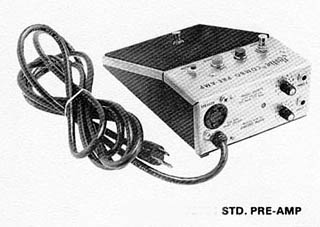 |
| Click here to download the manual for the
Leslie Combo Preamp II |
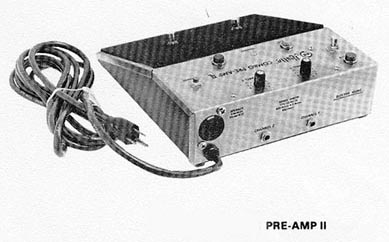 |
| Click here to download the manual for the
Leslie Combo Preamp III |
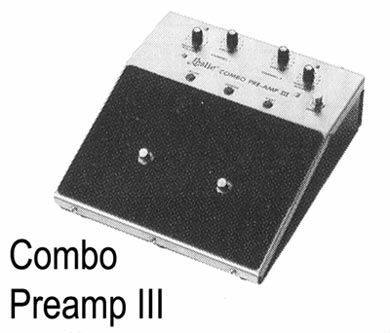 |
| Click
here to download the manual for the
Leslie Combo Preamp IV |
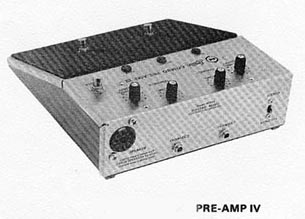 |
| Click here to download the manual for
the Leslie Combo Preamp De Luxe |
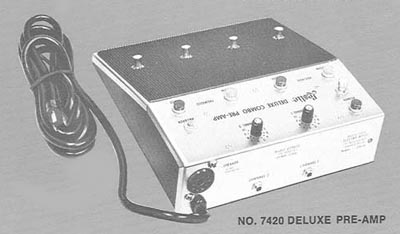 |
If you click here you can download an alternate version of the combo preamp II manual (for the console connector kit #7370).